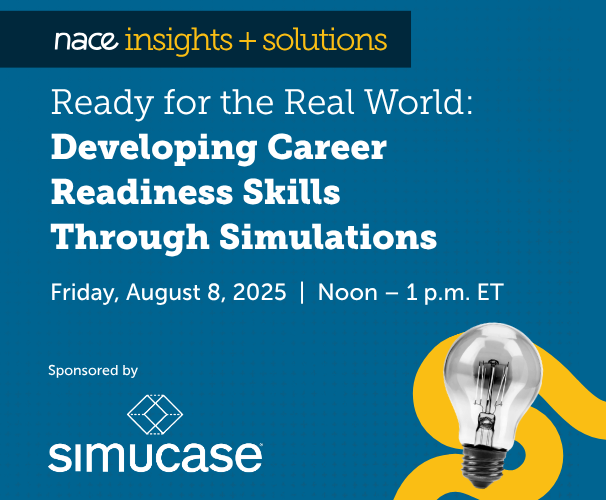Spotlight for Career Services Professionals
Staff mentorship programs, such as the one developed and launched at the Wasserman Center for Career Development at New York University (NYU), are important for onboarding and retention efforts because they help to shape institutional culture, equalize the experience of new hires, increase knowledge transfer, and enhance leadership development, explains Diana Mendez.
The Wasserman Center is a large career services office (50+ employees) that serves the entire NYU student and alumni population across three locations in New York City.
“New hires usually enter a complex workplace structure and culture, filled with multiple teams and reporting lines,” explains Mendez, senior assistant director of the Wasserman Center.
“This may impede career growth in the first year due to the difference in hiring and onboarding practices from team to team. Therefore, we sought to equalize the onboarding process of each new hire at Wasserman by offering them a ‘Wasser-Buddy’ or a mentor to be their guide for the first six months of employment. We developed the Wasser-Buddies program as a way to prepare all new hires for success and aid in upward mobility as they grow within the department. We also wanted to provide opportunities for community building and a shared acclimation experience for all new staff.”
The Wasser-Buddies program was developed by a steering committee that included Mendez; Joe Mercadante, associate director, employer engagement and strategic outreach; Brielle Picone, administrative aide; Alexa Spieler, recruitment program assistant; and Tiffany Garcia, manager of operations and events. The program, which launched in June of 2020, ran for six months and included 14 staff members (seven pairs) across the organization, from entry level to senior leadership.
Mercadante notes that new staff members participating in the program receive an informal and easy way to acclimate to the office, as well as to foster a strong sense of belonging and connection early in their tenure.
“Through Wasser-Buddies, we seek to provide new talent with a shared and consistent experience during their onboarding,” he explains.
“Throughout the program, mentees learn about office culture and institutional priorities, and are able to truly understand what success looks like from staff members who are well versed in the unspoken rules of establishing a strong presence in the office.”
Mendez stresses that this is especially important for marginalized identities entering a predominantly white institution (PWI).
“Some studies show that employee engagement and retention increases by 50% via staff mentorship programs,” she says.
“Therefore, by creating a stronger sense of belonging and community in all new hires, we hope to increase retention.”
Staff training is especially important in the context of a mentorship program because for both mentors and mentees, clear expectations must be laid out for the program to be successful.
“The Wasser-Buddies program is mentee-led,” Mendez points out, “so the most important message that we wanted the mentees to understand was that the relationship’s success rested on their initiative and leadership. It may sound like a lot of pressure but, in reality, once staff feel empowered to drive a mentorship relationship for their own benefit, they truly step up.”
Training for mentors is also important, Mendez adds, because they need to hold their mentees accountable to the goals that were agreed upon at the beginning of the program.
“This can be challenging because mentors need to have the ability to be tough, but fair; exhibit great listening skills; and offer unwavering support to their mentees,” she says.
“Our program offered a curriculum that clearly delineated the expectations of both mentors and mentees and provided ideas for topics that the pairs could discuss. We supplemented this with virtual content, including monthly emails with articles, infographics, videos, and online resources—from LinkedIn Learning, for instance—on how to maintain a successful mentorship relationship, especially in the virtual space.”
Mendez explains that, in general, the mentorship relationships are based on informal meetings about what makes a successful employee at Wasserman and how to navigate a large institution like NYU.
“Being that NYU is a PWI, it was important to also offer informal ways for all staff, including those from BIPOC communities, to increase their visibility, know about leadership opportunities early in their tenure, and be connected to key people in the office to showcase their skills,” she notes.
“By offering an equal and consistent knowledge transfer process for all new hires, we are hoping to level the playing field for all staff related to overall success within the office and at NYU. … [We paid] close attention to the ‘equity’ and ‘inclusion’ parts, so all staff have equal access to opportunities for upward mobility, regardless of their backgrounds, teams, or identities.”
Spieler says this was evident, for example, in the pre-program interest forms and during the matching process, including how the committee asked mentors and mentees about what groups they belong to at NYU and some of their identity descriptors.
“In doing so,” she continues, “we ensured that the matching process not only took into consideration staff members’ professional affiliations, but also their personal affiliations through a DEI lens.”
The biggest hurdle the Wasser-Buddies program had to clear was that, since it launched in the summer of 2020 when all staff at Wasserman were teleworking due to the pandemic, the steering committee needed to implement creative strategies to help foster a natural connection between mentees and mentors for a fully virtual mentorship program.
The committee shared resources and tips with program participants on building strong virtual relationships, and offered ideas to create more casual, virtual sessions, such as eating lunch together or going outside.
“This allowed for participants to create a less formal atmosphere in the virtual space and establish connections more easily with one another,” Picone explains.
“We overcame this challenge, and this is demonstrated in the mostly positive survey responses from both mentors and mentees regarding their satisfaction with the program. We are also excited that as we hire new staff, we will be able to introduce and implement in-person sessions, with virtual still being an option, so that pairs can more easily build rapport with each other.”
The steering committee measured the success of the Wasser-Buddies program via pre- and post-program surveys with all mentors and mentees. It has also conducted midway program check-ins to obtain verbal feedback, accompanied by a survey, and asked for testimonials from all participants at the end of the program.
The surveys collected both quantitative and qualitative information that assessed program satisfaction, skill development, pre- and post-program impressions and outcomes, and feedback for future iterations of the program. For the end of the program mentee satisfaction survey, the committee received feedback from all seven mentees. Highlights include:
- Mentee satisfaction was generally high with the program: 62.5% reported feeling very satisfied and 37.5% reported feeling satisfied across eight areas, including the application process, the pairing process, information about the goals of the program, information about their role as a mentee, frequency of tip emails and general information, their mentorship relationship, the support they received from the committee, and the overall organization of the program.
- The majority of mentees (57.2%) said that the mentoring relationship had either a “great deal” or “somewhat” of an impact on their day-to-day work/professional experience.
- The majority of mentees (85.7%) indicated that they would like to serve as a mentor in the future.
- The majority of mentees (85.7%) felt highly acclimated to Wasserman after the program, 85.7% of mentees felt they understood the Wasserman culture better, and 57.1% of mentees felt that they understood the structures of Wasserman and/or NYU better.
In addition, the steering committee sent mentors and mentees an unannounced “Wasser-Buddies Post-Program Check-In” three months after the completion of the program to assess how strong and genuine the relationship was outside of the confines of a formal mentoring program and to determine if mentors and mentees continued to be in touch. The committee received 10 responses (seven mentees and three mentors) out of 14 possible responses, with the following results:
- The majority (eight out of 10) have remained in touch monthly or a few times a month, and the minority (two) have remained in contact weekly.
- The contact has been originated by the mentee 60% of the time.
- Nearly all of them (90%) keep in contact over GChat, 40% via Zoom or phone calls, 30% via email, and 10% over text.
The steering committee offers several recommendations for career centers to take when developing or managing a mentorship program, including:
- Getting buy-in from leadership—“You will need that support to truly build a meaningful and well- thought-out program. We were very lucky that our senior leadership team supported this program from the moment it was pitched, through the building out of the team, and now, after seeing the successful results of the pilot, making it part of Wasserman’s onboarding model for all new hires.”
- Building excitement around the program—“Do so by emphasizing the ‘equity’ aspect of it. Our main goal was always to equalize the onboarding experience of new hires and to build a sense of belonging from the moment new staff started to work in our office. This is crucial for offices or teams that are truly committed to diversity, belonging, and inclusion as part of their mission.
- Consistently checking in with participants—“Maintain ties through emails, surveys, and video calls. This has been extremely helpful in the management of a staff mentorship program. Through this, we were able to gain immediate feedback from both mentors and mentees and promptly respond to their needs or concerns.”
- Setting expectations early—“We made it very clear to participants from the start that this program would be mentee-led. We put the responsibility on mentees to coordinate meetings, define goals, and set expectations for their relationships with their mentors. This helped empower them to think seriously about their goals and what they genuinely wanted to gain from this program. Mentees learned how to shape their own individual experience and make this program what they wanted it to be, which is an incredible lesson for any new staff member to learn.”
“In a truly unprecedented year that prevented many from connecting in a genuine way, this mentorship program provided professionals—both new and seasoned—an opportunity to re-explore and re-examine their work spaces through the experience of their Wasser-Buddy,” Garcia adds.
“In a time when many felt isolated or overburdened by home responsibilities, each member had an opportunity to directly connect with someone in a very low-risk way, such as a 15-minute coffee chat, a group catch up, or other, that allowed them to bring their full selves to work. Rarely do we make the connection between productivity and building a sense of belonging on purpose. This program did exactly that.”







